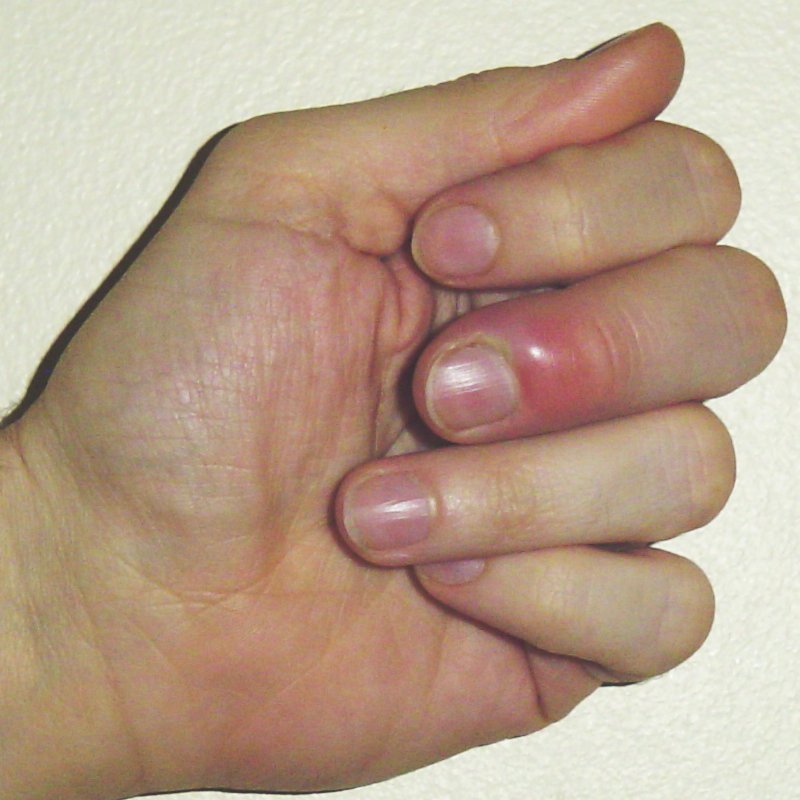- Paronychia
Infobox_Disease
Name = PAGENAME

Caption =
DiseasesDB = 9663
ICD10 = ICD10|L|03|0|l|00
ICD9 = ICD9|681.02, ICD9|681.11
ICDO =
OMIM =
MedlinePlus = 001444
eMedicineSubj = derm
eMedicineTopic = 798
MeshID = D010304The
nail disease paronychia (commonly misidentified as a synonym for felon or whitlow, the latter two of which refer to a deep space infection of thedistal end of a digit) is an often tender bacterial or fungalhand infection where the nail and skin meet at the side or the base of a finger ortoenail . It can start suddenly (acute paronychia) or gradually (chronic paronychia).Description
Dr. Rob Hicks writes on the BBC website:
The
cuticle acts as a protective seal but if it's damaged in any way bacteria can enter the skin and cause infection. These infections can be extremely painful as the skin becomes inflamed, hot, red and throbs continually.Cite web
url=http://www.bbc.co.uk/health/ask_the_doctor/whitlow.shtml
title=Doctor's advice Q: Whitlow (paronychia)
publisher=bbc.co.uk
accessdate=2008-05-10]Pus is usually present, along with gradual thickening and browning discoloration of the nail plate.Hicks continues:
If a large amount of
pus has collected, then it may be necessary to make a small cut in the skin (sometimes underlocal anaesthetic ) to release it.cite web | author=Jacobs, J.R. | url=http://www.collegehealth-e.org/3/n04.htm | title=Pathophysiology and Management of Paronychia | publisher=collegehealth-e | Issue=3 | date=2006 June-July | pp. 10–12]Acute paronychia is usually caused by bacteria. This is often treated with
antibiotics , sometimes as a cream, other times orally. Chronic paronychia is most often caused by ayeast infection of the soft tissues around the nail but can also be traced to a bacterial infection. If the infection goes on and on then afungal infection is often the cause and this needs anti-fungal cream or paint to treat it.Hicks writes further about the causes:
Whitlows are common, especially for people who have to repeatedly wash their hands. Excess water weakens the seal, while
soaps anddetergents remove the protective skin oils leaving the skin dry and more liable to split.Most often, trauma to the cuticle allows infection in. Biting or picking at the cuticle, damage through work and overenthusiastic manicuring are the usual culprits.
If someone has a
cold sore and puts their finger in their mouth then aherpes infection whitlow may appear.Individuals who work with their hands in water, such as health care workers and food processors, are quite prone to the fungal type of infection.
Herpes whitlows are frequently found among dentists and dental hygienists.cite journal |author=Lewis MA |title=Herpes simplex virus: an occupational hazard in dentistry |journal=Int Dent J |volume=54 |issue=2 |pages=103–11 |year=2004 |pmid=15119801 |doi=10.2956/indj.2004.54.2.103 |url=http://www.atypon-link.com/FDI/doi/abs/10.2956/indj.2004.54.2.103 |doi_brokendate=2008-08-12] Prosector's paronychia is a primary inoculation oftuberculosis of the skin and nails, named after its association withprosector s, who prepare specimens for dissection. Paronychia around the entire nail is sometimes referred to as "runaround paronychia".Painful paronychia in association with a scaly,
erathematous ,keratotic rash (papules and plaques) of the ears, nose, fingers, and toes, may be indicative ofacrokeratosis paraneoplastica , which is associated withsquameous cellcarcinoma of thelarynx .cite web | title=eMedicine - Acrokeratosis Neoplastica | author= Karen Allen, MD | url=http://www.emedicine.com/derm/topic6.htm | date=2005-08-17 ]References
External links
*
* [http://www.podiatrytoday.com/article/255 "What Is The Best Way To Treat Paronychias?,] Roundtable discussion in "Podiatry Today ," Volume 15 - Issue 3, March 2002, pp. 58-60.
Wikimedia Foundation. 2010.
